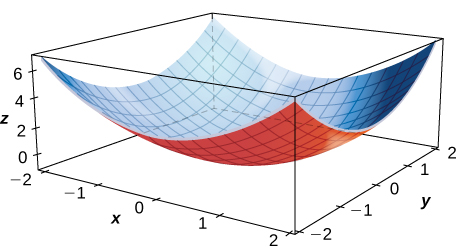Partial Derivatives (Exercises)
- Last updated
- Jun 14, 2019
- Save as PDF
- Page ID
- 21122
( \newcommand{\kernel}{\mathrm{null}\,}\)
In the following exercise, calculate the partial derivative using the limit definitions only.
1) ∂z∂y for z=x2−3xy+y2
- Answer
- ∂z∂y=−3x+2y
For exercises 2 - 5, calculate the sign of the partial derivative using the graph of the surface.

2) fx(1,1)
3) fx(−1,1)
- Answer
- The sign is negative.
4) fy(1,1)
5) fx(0,0)
- Answer
- The partial derivative is zero at the origin.
In exercises 6 - 16, calculate the requested partial derivatives.
6) ∂z∂x for z=sin(3x)cos(3y)
7) ∂z∂y for z=sin(3x)cos(3y)
- Answer
- ∂z∂y=−3sin(3x)sin(3y)
8) ∂z∂x and ∂z∂y for z=x8e3y
9) ∂z∂x and ∂z∂y for z=ln(x6+y4)
- Answer
- ∂z∂x=6x5x6+y4;∂z∂y=4y3x6+y4
10) Find fy(x,y) for f(x,y)=exycos(x)sin(y).
11) Let z=exy. Find ∂z∂x and ∂z∂y.
- Answer
- ∂z∂x=yexy;∂z∂y=xexy
12) Let z=ln(xy). Find ∂z∂x and ∂z∂y.
13) Let z=tan(2x−y). Find ∂z∂x and ∂z∂y.
- Answer
- ∂z∂x=2sec2(2x−y),∂z∂y=−sec2(2x−y)
14) Let z=sinh(2x+3y). Find ∂z∂x and ∂z∂y.
15) Let f(x,y)=arctan(yx). Evaluate fx(2,−2) and fy(2,−2).
- Answer
- fx(2,−2)=14=fy(2,−2)
16) Let f(x,y)=xyx−y. Find fx(2,−2) and fy(2,−2).
17) Find ∂z∂x at (0,1) for z=e−xcos(y).
- Answer
- ∂z∂x=−cos(1)
18) Given f(x,y,z)=x3yz2, find ∂2f∂x∂y and fz(1,1,1).
19) Given f(x,y,z)=2sin(x+y), find fx(0,π2,−4), fy(0,π2,−4), and fz(0,π2,−4).
- Answer
- fx(x,y,z)=0,fy(x,y,z)=0,fz(x,y,z)=0
20) The area of a parallelogram with adjacent side lengths that are a and b, and in which the angle between these two sides is θ, is given by the function A(a,b,θ)=basin(θ).Find the rate of change of the area of the parallelogram with respect to the following:
a. Side a
b. Side b
c. Angle θ
21) Express the volume of a right circular cylinder as a function of two variables:
a. its radius r and its height h.
b. Show that the rate of change of the volume of the cylinder with respect to its radius is the product of its circumference multiplied by its height.
c. Show that the rate of change of the volume of the cylinder with respect to its height is equal to the area of the circular base.
- Answer
- a.V(r,h)=πr2h
b.∂V∂r=2πrh
c.∂V∂h=πr2
22) Calculate ∂w∂z for w=zsin(xy2+2z).
In exercises 23 - 39, find the indicated higher-order partial derivatives.
23) fxy(x,y) for f(x,y)=ln(x−y)
- Answer
- fxy(x,y)=1(x−y)2
24) fyx(x,y) for f(x,y)=ln(x−y)
25) Let z=x2+3xy+2y2. Find ∂2z∂x2 and ∂2z∂y2.
- Answer
- ∂2z∂x2=2,∂2z∂y2=4
26) Given z=extany, find ∂2z∂x∂y and ∂2z∂y∂x.
27) Given f(x,y,z)=xyz, find fxyy(x,y,z),fyxy(x,y,z), and fyyx(x,y,z).
- Answer
- fxyy(x,y,z)=fyxy(x,y,z)=fyyx(x,y,z)=0
28) Given f(x,y,z)=e−2xsin(z2y), show that fxyy(x,y,z)=fyxy(x,y,z).
29) Show that z=12(ey−e−y)sinx is a solution of the differential equation ∂2z∂x2+∂2z∂y2=0.
- Answer
- d2zdx2=−12(ey−e−y)sinx
d2zdy2=12(ey−e−y)sinx
d2zdx2+d2zdy2=0
30) Find fxx(x,y) for f(x,y)=4x2y+y22x.
31) Let f(x,y,z)=x2y3z−3xy2z3+5x2z−y3z. Find fxyz.
- Answer
- fxyz(x,y,z)=6y2x−18yz2
32) Let F(x,y,z)=x3yz2−2x2yz+3xz−2y3z. Find Fxyz(x,y,z).
33) Given f(x,y)=x2+x−3xy+y3−5, find all points at which fx(x,y)=fy(x,y)=0 simultaneously.
- Answer
- (14,12),(1,1)
34) Given f(x,y)=2x2+2xy+y2+2x−3, find all points at which ∂f∂x=0 and ∂f∂y=0 simultaneously.
35) Given f(x,y)=y3−3yx2−3y2−3x2+1, find all points on f at which fx(x,y)=fy(x,y)=0 simultaneously.
- Answer
- (0,0),(0,2),(√3,−1),(−√3,−1)
36) Given f(x,y)=15x3−3xy+15y3, find all points at which fx(x,y)=fy(x,y)=0 simultaneously.
37) Show that z=exsiny satisfies the equation ∂2z∂x2+∂2z∂y2=0.
- Answer
- ∂2z∂x2+∂2z∂y2=exsiny−exsiny=0
38) Show that f(x,y)=ln(x2+y2) solves Laplace’s equation ∂2z∂x2+∂2z∂y2=0.
39) Show that z=e−tcos(xc) satisfies the heat equation ∂z∂t=−e−tcos(xc).
- Answer
- c2∂2z∂x2=e−tcos(xc)
40) Find lim for f(x,y)=−7x−2xy+7y.
41) Find \displaystyle \lim_{Δy→0}\frac{f(x,y+Δy)−f(x,y)}{Δy} for f(x,y)=−7x−2xy+7y.
- Answer
- \dfrac{∂f}{∂y}=−2x+7
42) Find \displaystyle \lim_{Δx→0}\frac{Δf}{Δx}=\lim_{Δx→0}\frac{f(x+Δx,y)−f(x,y)}{Δx} for f(x,y)=x^2y^2+xy+y.
43) Find \displaystyle \lim_{Δx→0}\frac{Δf}{Δx}=\lim_{Δx→0}\frac{f(x+Δx,y)−f(x,y)}{Δx} for f(x,y)=\sin(xy).
- Answer
- \dfrac{∂f}{∂x}=y\cos xy
44) The function P(T,V)=\dfrac{nRT}{V} gives the pressure at a point in a gas as a function of temperature T and volume V. The letters n and R are constants. Find \dfrac{∂P}{∂V} and \dfrac{∂P}{∂T}, and explain what these quantities represent.
45) The equation for heat flow in the xy-plane is \dfrac{∂f}{∂t}=\dfrac{∂^2f}{∂x^2}+\dfrac{∂^2f}{∂y^2}. Show that f(x,y,t)=e^{−2t}\sin x\sin y is a solution.
46) The basic wave equation is f_{tt}=f_{xx}. Verify that f(x,t)=\sin(x+t) and f(x,t)=\sin(x−t) are solutions.
47) The law of cosines can be thought of as a function of three variables. Let x,y, and θ be two sides of any triangle where the angle θ is the included angle between the two sides. Then, F(x,y,θ)=x^2+y^2−2xy\cos θ gives the square of the third side of the triangle. Find \dfrac{∂F}{∂θ} and \dfrac{∂F}{∂x} when x=2,\,y=3, and θ=\frac{π}{6}.
- Answer
- \dfrac{∂F}{∂θ}=6,\quad \dfrac{∂F}{∂x}=4−3\sqrt{3}
48) Suppose the sides of a rectangle are changing with respect to time. The first side is changing at a rate of 2in./sec whereas the second side is changing at the rate of 4 in/sec. How fast is the diagonal of the rectangle changing when the first side measures 16 in. and the second side measures 20 in.? (Round answer to three decimal places.)
49) A Cobb-Douglas production function is f(x,y)=200x^{0.7}y^{0.3}, where x and y represent the amount of labor and capital available. Let x=500 and y=1000. Find \dfrac{∂f}{∂x} and \dfrac{∂f}{∂y} at these values, which represent the marginal productivity of labor and capital, respectively.
- Answer
- \dfrac{∂f}{∂x} at (500,1000)=172.36, \quad \dfrac{∂f}{∂y} at (500,1000)=36.93
50) The apparent temperature index is a measure of how the temperature feels, and it is based on two variables: h, which is relative humidity, and t, which is the air temperature.
A=0.885t−22.4h+1.20th−0.544. Find \dfrac{∂A}{∂t} and \dfrac{∂A}{∂h} when t=20°F and h=0.90.

